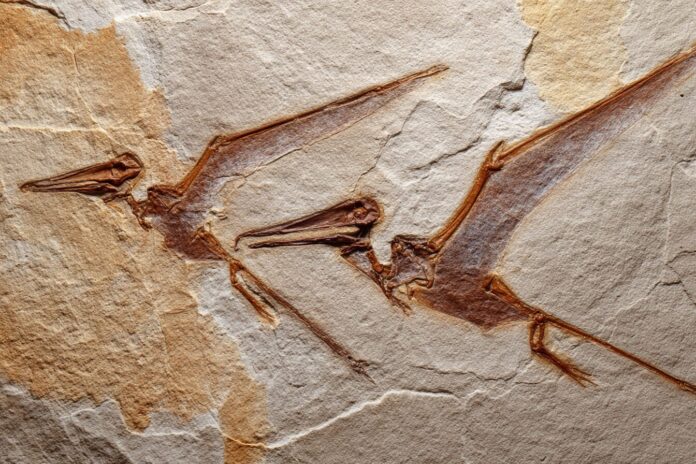Pterosaurs, the iconic flying reptiles of the Jurassic, have long fascinated paleontologists with their mysterious lifestyles and tragic ends. Recent discoveries have deepened our understanding of how young pterosaurs, notably species like Pterodactylus antiquus, encountered catastrophic fates during violent storm events. Most importantly, these paleontological breakthroughs reveal that powerful storms were not only regular weather events but acted as fatal predators for these delicate juveniles.
Unraveling the Fossilized Clues
Over the years, fossils meticulously preserved in Germany’s Solnhofen Limestones have provided rare glimpses into the final moments of these baby pterosaurs. Detailed studies of specimens nicknamed Lucky I and Lucky II illustrate clean, slanted fractures on their wing bones. These fractures were caused by a violent twisting force, not by blunt trauma or predation. Therefore, the injuries recorded by researchers clearly support the hypothesis that brutal atmospheric winds played a decisive role in their deaths. For further details on these findings, you can explore this analysis on the Independent and additional insights on Sci.News.
In addition, paleontologists have drawn parallels between these fossilized injuries and similar patterns observed in modern birds and bats affected by fierce gusts. Because these young flyers were only days or weeks old, they were naturally more vulnerable. Consequently, the fossil evidence confirms that the overwhelming force of Jurassic storms triggered rapid fatal injuries, leaving behind a unique signature etched in stone.
Storms as Nature’s Harsh Arbiter
Severe weather conditions, most importantly recurrent violent storms, played a critical role in shaping the fate of these ancient animals. Because young pterosaurs lacked the strength to withstand such powerful winds, they were easily overpowered by nature. Therefore, once caught in a storm, the juveniles were swiftly swept away into shallow lagoons where turbulent waters sealed their destiny. As described by sources like Daily Galaxy, the final moments of these creatures were marked by a rapid descent into watery graves.
Besides that, high-energy storm events not only led to traumatic injuries but also ensured that the bodies of these fragile animals were rapidly buried. Because rapid burial is essential for preserving delicate remains, this process effectively locked in details that have since allowed scientists to reconstruct events from a staggering 150 million years ago. The rapid sedimentation acted as a natural preservative, capturing the pterosaurs’ flight and demise in exquisite detail.
The Fossilization Process and Its Significance
Most importantly, the exceptional preservation of these fossils is linked to the rapid burial in fine lime mud created by storm-driven waves. This sedimentation process, which occurred almost instantaneously, protected the remains from decay and scavenging. Consequently, researchers have been able to study microscopic details like fractured wing bones and other vital skeletal features that would have otherwise been lost. Additional evidence of this process is discussed in studies available on EurekAlert and ScienceDaily.
Furthermore, the exceptional fossilization process has highlighted an inherent bias present in the Solnhofen fossil record, where smaller and more delicate specimens are overrepresented. This discovery encourages scientists to reconsider previous assumptions about the prevalence of juvenile pterosaurs in ancient ecosystems, thereby reshaping our understanding of Jurassic biodiversity.
Implications for Jurassic Ecosystems and Modern Research
These groundbreaking findings force us to re-examine long-held perceptions about the structure of Jurassic ecosystems. Because many juvenile fossils originated from storm-induced mortality rather than long-term habitation, there is a significant preservation bias that influences our interpretation. Therefore, while small pterosaur remains are abundant, it does not necessarily mean they dominated these ancient habitats. Instead, these fossils reveal the tragic stories of vulnerable youngsters caught in the grip of nature’s brutality.
Most importantly, understanding the dynamics of these ancient storms enriches modern paleontology by offering insights into how weather can influence fossil records. Researchers can apply this knowledge when studying other fossil sites, bridging the gap between historical weather phenomena and their ecological impacts. Besides that, these studies also highlight the importance of integrating modern meteorological data with paleontological research for a holistic interpretation of the past.
Conclusion: Revisiting a Prehistoric Tragedy
In conclusion, the story of juvenile pterosaurs like Lucky I and Lucky II is both dramatic and enlightening. These fossils serve as a stark reminder of the unpredictable and often violent forces of nature. Because the evidence highlights the impact of severe storm events on these young creatures, paleontologists are now better equipped to understand the intricate dance between biology and climatic factors during the Jurassic period.
Moreover, these findings urge us to critically evaluate the fossil record. Most importantly, by incorporating new data and reassessing previous interpretations, scientists continue to refine our understanding of prehistoric life. This enriched perspective not only deepens our insight into ancient ecosystems but also illustrates how extreme weather events can shape evolutionary trajectories, leaving a lasting mark on the earth’s geological history.



